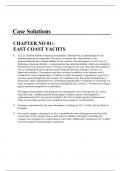Case Solutions
CHAPTER NO 01:-
EAST COAST YACHTS
1. An LLC (limited liability company) is essentially a hybrid form of a partnership (or sole
proprietorship) and a corporation. The goal is to operate like a partnership or sole
proprietorship but have limited liability for the owner(s). The advantages to an LLC are: (1)
Reduction of personal liability. A sole proprietor has unlimited liability, which can include the
potential loss of all personal assets. (2) Taxes. Forming an LLC may mean that more expenses
can be considered business expenses and be deducted from the company’s income. (3)
Improved credibility. The business may have increased credibility in the business world
compared to a sole proprietorship. (4) Ability to attract investment. Corporations, even LLCs,
can raise capital through the sale of equity. (5) Continuous life. Sole proprietorships have a
limited life, while corporations have a potentially perpetual life. (6) Transfer of ownership. It is
easier to transfer ownership in a corporation through the sale of stock. (7) Potential for reduced
agency problems compared to a corporation.
The biggest disadvantage is the potential cost, although the cost of forming an LLC can be
relatively small. Another potential disadvantage is double taxation, which applies to
corporations and LLCs, but can be avoided for the LLC if certain specific criteria are met.
There are also other potential costs, including more expansive record-keeping.
2. Forming a corporation has the same advantages as forming an LLC, but the costs are likely to
be higher.
3. As a small company, changing to an LLC is probably the most advantageous decision at the
current time. If the company grows, and Larissa is willing to sell equity ownership, the
company can reorganize as a corporation at a later date. Additionally, forming an LLC is likely
to be less expensive than forming a corporation.
,CHAPTER NO 02:-
CASH FLOWS AT EAST COAST YACHTS
The operating cash flow for the company is:
OCF = EBIT + Depreciation − Current taxes
OCF = $62,548,100 + 16,166,700 − 13,409,525
OCF = $65,304,275
To calculate the cash flow from assets, we need to find the capital spending and change in net
working capital. The capital spending for the year was:
Capital Spending
Ending net fixed assets $284,716,900
− Beginning net fixed assets 257,275,000
+ Depreciation 16,166,700
Net capital spending $43,608,600
Alternatively, the company purchased $48.15 million in fixed assets and sold $4,541,400, for a
total capital spending of $43,608,600.
And the change in net working capital was:
Change in Net Working Capital
Ending NWC $201,725
− Beginning NWC −25,900
Change in NWC $227,625
So, the cash flow from assets was:
Cash Flow From Assets
Operating cash flow $65,305,275
− Net capital spending 43,608,600
− Change in NWC 227,625
Cash flow from assets $21,469,050
, CHAPTER 2 C-3
The cash flow to creditors was:
Cash Flow to Creditors
Interest $8,910,000
Retirement of debt 18,270,000
Debt service $27,180,000
− Proceeds from sale of long-term 32,400,000
debt
Total −$5,220,000
Alternatively
Beginning long-term debt
$123,070,000
Ending long-term debt 137,200,000
Interest 8,910,000
Total −$5,220,000
The cash flow to stockholders was:
Cash flow to stockholders
Dividends $17,437,050
Repurchase of stock 28,872,000
Cash to stockholders $46,309,050
− Proceeds from new stock issue 19,620,000
Total $26,689,050
Alternatively
Beginning total equity $134,179,100
− Ending total equity 147,718,625
Dividends 17,437,050
Retained earnings 22,791,525
Total $26,689,050
And the cash flow identity was:
Cash flow from assets = Cash flow to creditors + Cash flow to stockholders
$21,469,050 = −$5,220,000 + 26,689,050
, C - 4 CASE SOLUTIONS
The accounting statement of cash flows for the year was:
Accounting Statement of Cash Flows
Operations
Net income $40,228,575
Depreciation 16,166,700
Changes in assets and liabilities
Accounts receivable 197,600
Inventories −2,478,300
Accounts payable 1,826,075
Accrued expenses 763,400
Other −60,200
Total cash flow from operations $56,643,850
Investing activities
Acquisition of fixed assets −$48,150,000
Sale of fixed assets 4,541,400
Total cash flow from investing activities −$43,608,600
Financing activities
Retirement of debt −$18,270,000
Proceeds of long-term debt 32,400,000
Dividends −17,437,050
Repurchase of stock −28,872,000
Proceeds from new stock issues 19,620,000
Total cash flow from financing activities −$12,559,050
Change in cash (on balance sheet) $476,200




